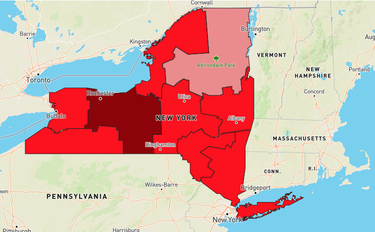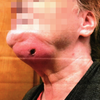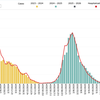State’s health department warns: More ticks, more bites, more disease
ALBANY COUNTY — Warmer temperatures and changing climate conditions have contributed to a steady rise in ticks across New York and an increased risk of tick bites — even in areas and seasons where risk was once considered low, according to a release from the governor’s office, which outlined the reach of tick-borne illnesses and included advice for prevention.
Reported cases of Lyme disease, the most commonly reported tick-borne illness in the state, and other tick-borne illnesses have continued to climb in recent years. Over the last three years, New York state has averaged more than 17,500 new cases of Lyme disease each year, with more than 19,000 cases reported in 2023 alone, the highest in recent history.
In Albany County last year, according to data from the state’s health department, 871 ticks were collected from 12 sites, showing a population density of 41.69 percent.
Of the 150 ticks that were tested:
— 63 percent tested positive for Borrelia burgdorferi, a bacterial species of the spirochete class in the genus Borrelia, which is one of the causative agents of Lyme disease;
— 15 percent tested positive for Babesia microti, which causes babesiosis;
— 10 percent tested positive for Anaplasma phagocytophilum, which causes anaplasmosis; and
— 0.7 percent tested positive for Borrelia miyamotoi, a bacterium, which causes a disease of that name.
The bacteria that causes Lyme disease is transmitted by blacklegged (deer) ticks — both nymphs and adults — and is spread when an infected tick bites a person and remains attached for 36 hours or more.
Bites from the nymphal life stage of this tick lead to most cases of Lyme disease, because the tick is so small — the size of a poppy seed — and is often not detected within that 36-hour window.
Ticks are active throughout the spring, summer, and fall. Tick and mosquito populations can vary with weather conditions, habitat and other environmental factors including elevation. For example, warmer temperatures and rainfall can create more mosquito breeding habitats and faster development time, leading to higher mosquito populations.
Lyme disease can affect people of any age. The most common symptom is an expanding rash resembling a bull’s eye or solid patch that appears near the site of a bite. Flu-like symptoms such as fever or chills and muscle aches, headache, or fatigue may also occur within 30 days of infection. If these symptoms develop, it’s important to seek treatment from a health care provider immediately.
Tick bites can also transmit other diseases. Since 2015, the state’s health department has reported an average of 600 babesiosis infections and an average of 1,300 anaplasmosis infections across New York each year, as well as cases of more rare diseases such as ehrlichiosis, Rocky Mountain spotted fever, and Powassan virus disease.
All of these diseases can vary in severity, and without treatment, they can cause serious illness and even death. Avoiding tick bites and prompt removal of attached ticks are important, as transmission of these diseases can occur more quickly than Lyme disease. Powassan virus can be transmitted within 15 minutes of a tick bite.
Mosquito-borne diseases are also a potential threat to New Yorkers. Cases of West Nile virus infection occur each year with an average of 55 cases reported each year from 2020 to 2023.
Last year, two human cases of Eastern equine encephalitis were reported, the first human cases reported in New York state since 2015. Diseases transmitted by mosquitoes can affect people of any age and may not lead to any symptoms but can also result in mild to severe illness and rarely, can result in death.
Advice
While hiking, working, or spending time outdoors, the state’s health department advises following these steps to help prevent tick bites:
— Wear light-colored long pants, long-sleeved shirts, and closed-toed shoes;
— Keep long hair tied back, especially when gardening;
— Check for ticks often while outdoors and brush them away before they attach;
— Perform a full body check multiple times during the day, as well as at the end of the day, to ensure that no ticks are attached;
— Tumble clothes in a dryer on high heat for 10 minutes to kill ticks on dry clothing after you come indoors;
— Shower soon after coming indoors;
— Remember to check pets thoroughly for ticks after spending time outdoors and talk to your veterinarian about ways to reduce ticks on your pet;
— Consider using repellents registered with the Environmental Protection Agency labelled as effective against ticks containing 40 percent DEET, 20 percent picaridin or IR3535, and follow label instructions. If you are using sunscreen, apply sunscreen first and insect repellent second;
— Consider wearing clothing treated with permethrin. Permethrin is an insecticide that kills and repels ticks. While it should not be applied directly to skin, permethrin-treated clothing provides protection through multiple washings.
If you find an attached tick, use fine-tipped tweezers to remove it right away. Avoid risky removal strategies such as detergent or burning, as these could increase your risk of infection. See the Department of Health's website for a video on proper tick removal technique.
For mosquitoes:
— Cover your skin as completely as possible when outside at sunrise, sunset, and early in the evening when mosquitoes are most active;
— Wear long sleeves, pants, and socks;
— Use EPA-registered insect repellent on exposed skin and follow label instructions. If you are using sunscreen, apply sunscreen first and insect repellent second;
— Consider wearing clothing treated with permethrin. Permethrin is an insecticide that kills and repels mosquitoes. While it should not be applied directly to skin, permethrin-treated clothing provides protection through multiple washings; and
— Cover strollers and baby carriers with mosquito netting.
The state’s health department and its partners routinely collect and analyze tens of thousands of ticks from across New York state each year to better understand the tick population, tick behavior, and regional trends in diseases carried by ticks. Current and retrospective tick collection and testing results are publicly available on the Department's Health Data NY website.
For more information about Lyme disease and other tick-borne diseases, visit https://www.health.ny.gov/diseases/communicable/lyme/.
For information about how to reduce mosquitoes around your property and mosquito-borne diseases, visit https://www.health.ny.gov/diseases/mosquitoes/.



